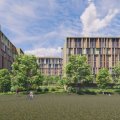A $32 million building which meets the world’s most advanced levels of sustainability was officially opened by Her Excellency Dr Penelope Wensley AC, Governor of Queensland at the University of Queensland (UQ) on Wednesday 28 August.
The bold new Global Change Institute (GCI) building at UQ’s St Lucia campus was made possible by a $15 million donation from UQ alumnus and prominent philanthropist Graeme Wood.
UQ President and Vice-Chancellor Professor Peter Høj said it was the latest example of UQ’s commitment to improving sustainability outcomes across the world.
“The Global Change Institute has created a hub where new ideas about sustainability and global climate change are expressed, debated, investigated and reported,” Professor Høj said.
“This building is the ideal home for the Institute’s game-changing research into clean energy, healthy oceans, food security and climate change.
“It is designed to work with the natural environment and it will operate as a zero-energy and zero-carbon workplace.
“It will be naturally ventilated for most of the year and generate and store all its own power on-site through renewable solar energy sources. All excess power will be delivered back to the national grid.”
The GCI building, designed by Hassell, represents the first Australian use of structural Geopolymer concrete, a low-carbon product produced with significantly lower greenhouse gas emissions than conventional concrete.
Global Change Institute Director Professor Ove Hoegh-Guldberg said his team wanted to push the boundaries and create a building that symbolised the Global Change Institute’s work.
“We wanted to ‘walk the talk’ of operating more sustainably,” he said.
“The building had to be functional, as well as help our researchers better understand how to maximise a space in a sub-tropical environment.
“The end-product is both aesthetically beautiful and challenging. The GCI team must learn to work in new ways and change their workplace behaviour,” Professor Hoegh-Guldberg said.
Hassell Principal Mark Roehrs, who led the project’s design team, said the GCI was attuned to its place and climate at the forefront of design innovation.
“The building moves away from a framework of consumption of the world’s resources to one that contributes to the restoration and regeneration of the environment,” Mr Roehrs said.
“It is able to act as a live research site, with the building systems and occupants used to assess optimal comfort conditions in low-energy buildings for the sub-tropics.”
The building features an operable sun shading system that tracks the sun and protects the glass louvres which create natural ventilation. The air flows across occupied spaces to the central atrium which acts as the building’s lungs, discharging warm air through its thermal chimney.
The translucent ETFE atrium roof optimises natural light to the interior and is also heat-resistant.
The building is cooled with chilled water flushed through exposed sculptural precast floor panels.
Rainwater storage of 60,000 litres services the hydronic cooling system, kitchen and shower.
Optimal natural lighting is supported by environmentally-friendly LED lighting.
A green wall, bush tucker garden and bio-retention basin breathe life into the building’s green ethos, and UQ’s St Lucia campus pedestrian links provide easy access by foot or bike.
The Global Change Institute is hosting several seminars and events to celebrate the opening of the building. Go to www.gci.uq.edu.au/events/global-change-expo for more information.
Media: Kate Hannah, Global Change Institute, 3365 3558 or k.hannah@uq.edu.au.













